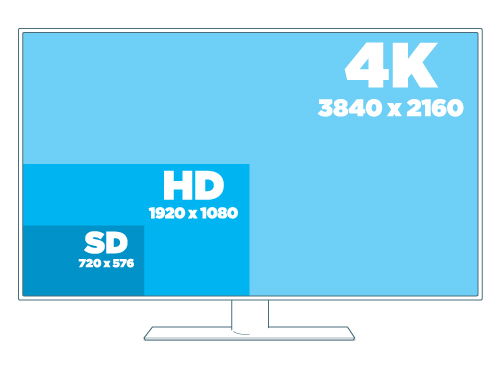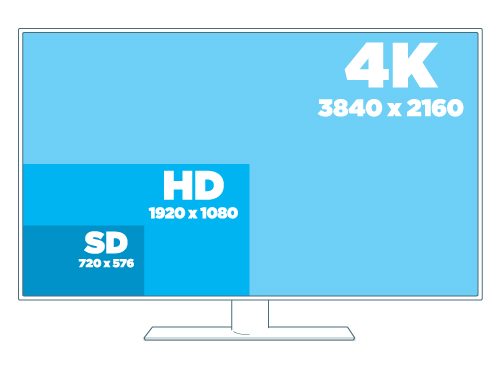

The Consumer Electronics Association (CEA) has announced "updated core characteristics" for 4K Ultra HD TVs – some of which mean existing 4K sets are no longer seemingly up to scratch.
The CEA says the 4K guidelines aim to provide "clarity for consumers and retailers alike", and will come into effect from September, with the organisation also revealing it is working with partners to develop an Ultra HD logo.
The new definition sees some existing Ultra HD TVs failing to make the CEA's grade – arguably not the "clarity" that the CEA had in mind.
For example, the Philips 55PUS7809, which we reviewed last month, only has HDMI 1.4 so can't deliver 4K video at all the required frame rates. Furthermore, few 4K TVs currently on the market support the HEVC codec, also listed as a required spec.
Others, such as the Panasonic TX-58AX802 we're currently testing, have the HEVC decoder built-in but it doesn't support playback of Netflix 4K content.
The various minimum specification requirements are only "voluntary guidelines" (again, ensuring it's by no means a given that all the TV manufacturers will sign up), but the CEA, as the body behind CES, certainly carries plenty of weight in the industry.
The new guidelines are as follows:
Get the What Hi-Fi? Newsletter
The latest hi-fi, home cinema and tech news, reviews, buying advice and deals, direct to your inbox.
Display Resolution – Has at least eight million active pixels, with at least 3840 horizontally and at least 2160 vertically.
Aspect Ratio – Has a width-to-height ratio of the display’s native resolution of 16:9 or wider.
Upconversion – Is capable of upscaling HD video and displaying it at Ultra High-Definition resolution.
Digital Input – Has one or more HDMI inputs supporting at least 3840 x 2160 native content resolution at 24p, 30p and 60p frames per second. At least one of the 3840x2160 HDMI inputs shall support HDCP revision 2.2 or equivalent content protection.
Colorimetry – Processes 2160p video inputs encoded according to ITU-R BT.709 colour space and may support wider colorimetry standards.
Bit Depth – Has a minimum color bit depth of eight bits.
There is also another set of guidelines related to network connectivity, with the CEA pointing to streaming as a crucial delivery method for 4K content. Whether this will be required in order to get the Ultra HD logo remains unclear...
Ultra High-Definition Capability – Meets all of the requirements listed above.
Video Codec – Decodes IP-delivered video of 3840 x 2160 resolution that has been compressed using HEVC and may decode video from other standard encoders.
Audio Codec – Receives and reproduces, and/or outputs multichannel audio.
IP and Networking – Receives IP-delivered Ultra HD video through a Wi-Fi, Ethernet or other appropriate connection.
Application Services – Supports IP-delivered Ultra HD video through services or applications on the platform of the manufacturer’s choosing.
The premise may be sound but these UHD guidelines remind us of the recent attempts to nail down a definition for high-resolution audio.
It will be interesting to see how many manufacturers get behind the new guidelines and the plans for a universal logo.
Also mentioned was the ongoing battle between 4K and Ultra HD, with the CEA suggesting the terms can still be used interchangeably: "The terms Ultra High-Definition, Ultra HD or UHD may be used in conjunction with other modifiers, for example, Ultra High-Definition TV 4K."
Look out for our test of 2014 4K TVs in the next issue of What Hi-Fi? Sound and Vision, on sale July 30th, in the meantime you can head to our 4K hub page for all our 4K TV reviews and news.
MORE: Best TV to buy in 2014
MORE: See all our TV reviews
by Joe Cox

Joe is the Content Director for What Hi-Fi? and Future’s Product Testing, having previously been the Global Editor-in-Chief of What Hi-Fi?. He has worked on What Hi-Fi? across the print magazine and website for almost 20 years, writing news, reviews and features on everything from turntables to TVs, headphones to hi-fi separates. He has covered product launch events across the world, from Apple to Technics, Sony and Samsung; reported from CES, the Bristol Show, and Munich High End for many years; and written for sites such as the BBC, Stuff and The Guardian. In his spare time, he enjoys expanding his vinyl collection and cycling (not at the same time).
